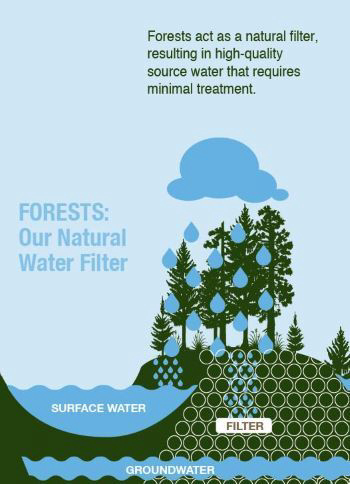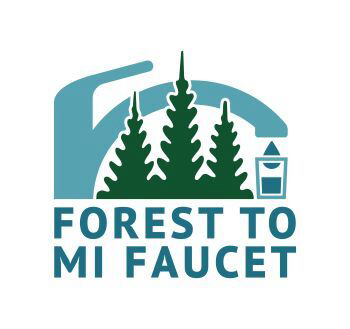

|
Six million people in Michigan get their drinking water from one of the Great Lakes. Four million people in Michigan get their drinking water from groundwater from municipal or private wells. You can learn about the source of your drinking water at MiDrinkingWater.org.
The quality of both groundwater and surface water is strongly influenced by how well we take care of the land above or upstream from our sources of drinking water. Michigan has 20 million acres of forest, with 38 percent manage by the state or federal government and 62 percent managed by families and corporations. Forests cover more than half of Michigan’s land (56%), so their permanent vegetation and undisturbed soils are essential for protecting our drinking water. We need to protect forests, manage forests well and plant more trees near water in both urban and rural places.
Forest to Mi Faucet is a project led by the Michigan Department of Natural Resources to explain connections between forests and drinking water for 10 million Michiganders. Twenty conservation partners working on Forest to Mi Faucet are planting 60,000 trees along rivers and lakes, protecting important forests with conservation easements, educating landowners about forest stewardship, and helping a dozen municipal water utilities protect the sources of their drinking water. More information about project partners and how you can protect forests and water is at Michigan.gov/ForestToMiFaucet.
Drinking Water Week is a great time to celebrate Michigan’s forests and how they protect the Great Lakes and other sources of your drinking water. The DNR and its partners on Forest to Mi Faucet would like to share a few things you can do to protect water quality, whether you live in a city, own a small woodlot or big forest.
If you live in a city
If you live in a suburban or rural area
If you own a small woodlot (1 to 24 acres)
If you own a larger forest (25 to 2,500 acres)
Forests cover over half of Michigan and deliver clean water to our rivers, inland lakes and the Great Lakes. Forests have permanent vegetation that slows water falling from the sky and moving along the ground. Forests have undisturbed soil and a layer of leaves on top that reduce runoff, limit erosion and filter pollutants. Forests have minimal infrastructure or impermeable surfaces like parking lots and rooftops that transport pollution into water. Chemical spills that might contaminate water quality are infrequent and small in forests. Forests absorb lots of water quickly and release it slowly to reduce flooding in heavy rain events.
Learn more
Contact Mike Smalligan at SmalliganM@Michigan.gov or 517-449-5666 with any questions about Forest to Mi Faucet.